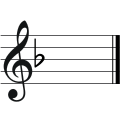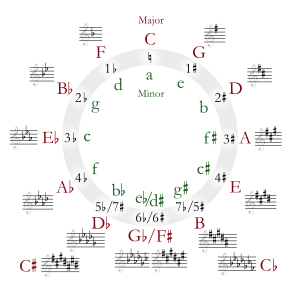D minor facts for kids
 |
||
| Relative key | F major | |
|---|---|---|
| Parallel key | D major | |
| Notes in this scale | ||
| D, E, F, G, A, B♭, C, D | ||
D minor is a special kind of musical scale that starts on the note D. Think of a scale as a set of musical notes played in order, like climbing up or down a ladder of sounds. In music, a "key" is like the home base for a song, and D minor is one of these home bases.
When you play music in D minor, it often has a serious, thoughtful, or even a bit sad sound. This is because it's a minor scale, which sounds different from a major scale (like D major), which usually sounds bright and happy. The key signature for D minor has one flat, which means the note B is always played as B-flat unless otherwise marked.
D minor has a close musical friend called its relative major, which is F major. They share the same key signature. It also has a parallel major key, which is D major. Both D minor and D major start on the note D, but they sound very different!
Contents
What is a Musical Scale?
A musical scale is a series of notes arranged in a specific order, usually going up or down. It's like the alphabet for music! Each scale has a unique sound and mood. There are many types of scales, but the most common ones are major and minor.
Major vs. Minor Scales
- Major scales often sound bright, happy, and uplifting. Think of a cheerful song.
- Minor scales often sound more serious, calm, or even a bit sad. Think of a thoughtful or dramatic piece of music.
The difference in sound comes from the specific pattern of whole steps and half steps between the notes in the scale.
The Notes of D Minor
The D minor scale can be played in a few different ways, but the most common is the natural minor scale. Here are the notes for the D natural minor scale:
- D
- E
- F
- G
- A
- B-flat
- C
- D (the next D, an octave higher)
You can see that the only note that is "flat" is B. This is why the key signature for D minor has one flat.
Other Types of D Minor Scales
Musicians also use two other versions of the minor scale to create different sounds:
- Harmonic Minor: This version raises the seventh note of the scale by a half step when going up and down. For D minor, the C becomes C-sharp. This creates a more dramatic sound.
- Melodic Minor: This version raises the sixth and seventh notes by a half step when going up, but plays them naturally when coming down. For D minor, B-flat becomes B-natural and C becomes C-sharp when going up. When coming down, it's B-flat and C again. This makes the melody sound smoother.
Key Signatures and the Circle of Fifths
A key signature is a set of sharps or flats placed at the beginning of a piece of music. It tells you which notes should always be played sharp or flat throughout the song, unless there's a special symbol to change it. D minor has one flat in its key signature, which is B-flat.
The Circle of Fifths is a helpful diagram that shows how all the major and minor keys are related to each other. It's arranged like a clock, and as you move around the circle, the number of sharps or flats in the key signature changes. D minor is found on the circle, showing its connection to F major and other keys.
| Diatonic Scales and Keys | |||||||||||||||||||||||||||||||||||||||||||||||||||||||
|---|---|---|---|---|---|---|---|---|---|---|---|---|---|---|---|---|---|---|---|---|---|---|---|---|---|---|---|---|---|---|---|---|---|---|---|---|---|---|---|---|---|---|---|---|---|---|---|---|---|---|---|---|---|---|---|
|
|||||||||||||||||||||||||||||||||||||||||||||||||||||||
| The table shows the number of sharps or flats in each scale. Minor scales are written in lower case. | |||||||||||||||||||||||||||||||||||||||||||||||||||||||
Famous Music in D Minor
Many famous composers have written beautiful and powerful pieces in D minor. Its serious and dramatic sound has inspired some of the most well-known music in history. Here are just a few examples:
- Johann Sebastian Bach wrote his famous Toccata and Fugue in D minor for organ, which is often used in movies and TV shows because of its powerful sound.
- Ludwig van Beethoven used D minor for the dramatic final movement of his Ninth Symphony, which includes the famous "Ode to Joy" chorus.
- Wolfgang Amadeus Mozart composed his intense Requiem in D minor.
- Johannes Brahms wrote his Piano Concerto No. 1 in D minor, a very grand and emotional piece.
These examples show how D minor has been used to create music that is both deep and memorable.
See also
 In Spanish: Re menor para niños
In Spanish: Re menor para niños


